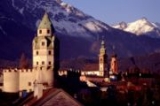
Burg Hasegg
Encyclopedia
Hasegg Castle is a castle and mint
located in Hall in Tirol
, Tyrol
, Austria.
Construction was completed soon after 1300, when Hall was rapidly becoming the center of Tyrolean commerce and salt mining. The building was originally erected to protect the salt mines, the shipping industry, the bridge across the river Inn and the old Roman Road. The castle's mint was established by Sigismund, Archduke of Austria
in 1477. The first dollar-size silver coin was struck in 1486: the Guldengroschen
.
When Ferdinand II, Archduke of Austria
had the old mint transferred from the Castle of Sparberegg to Hasegg in 1567, Hall experienced a decisive upswing. Between 1748 and 1768, Hasegg Castle became universally famous for its minting of silver Thaler
s of which it produced over 17 million specimens. The Thaler, a silver coin used throughout Europe for almost four hundred years, sees its name live on in various currencies as the "dollar
" or "tolar
".
The mint ceased production in 1806 due to the Napoleonic Wars and the increasing lack of local silver resources.
The mint in Hasegg Castle is a museum now, and open to the general public. Demonstrations of historical minting techniques are given from time to time. The castle itself is an example of early Gothic era Tirolean fortress architecture. The pointed roof of the mint tower is of heavily tarnished copper.
Mint (coin)
A mint is an industrial facility which manufactures coins for currency.The history of mints correlates closely with the history of coins. One difference is that the history of the mint is usually closely tied to the political situation of an era...
located in Hall in Tirol
Hall in Tirol
Hall in Tirol is a town in the Innsbruck-Land district of Tyrol, Austria. Located at an altitude of 574 m, about 5 km east of the state's capital Innsbruck in the Inn valley, it has a population of about 12,700 .-History:...
, Tyrol
Tyrol (state)
Tyrol is a state or Bundesland, located in the west of Austria. It comprises the Austrian part of the historical region of Tyrol.The state is split into two parts–called North Tyrol and East Tyrol–by a -wide strip of land where the state of Salzburg borders directly on the Italian province of...
, Austria.
Construction was completed soon after 1300, when Hall was rapidly becoming the center of Tyrolean commerce and salt mining. The building was originally erected to protect the salt mines, the shipping industry, the bridge across the river Inn and the old Roman Road. The castle's mint was established by Sigismund, Archduke of Austria
Sigismund, Archduke of Austria
Sigismund of Austria, Duke, then Archduke of Further Austria was a Habsburg archduke of Austria and ruler of Tirol from 1446 to 1490....
in 1477. The first dollar-size silver coin was struck in 1486: the Guldengroschen
Guldengroschen
The Guldengroschen was a large silver coin originally minted in Tirol in 1486.The Guldengroschen's name comes from the fact that it has an equivalent denomination value in silver relative to that of the goldgulden...
.
When Ferdinand II, Archduke of Austria
Ferdinand II, Archduke of Austria
Ferdinand II, Archduke of Further Austria was ruler of Further Austria including Tirol.-Life account:...
had the old mint transferred from the Castle of Sparberegg to Hasegg in 1567, Hall experienced a decisive upswing. Between 1748 and 1768, Hasegg Castle became universally famous for its minting of silver Thaler
Thaler
The Thaler was a silver coin used throughout Europe for almost four hundred years. Its name lives on in various currencies as the dollar or tolar. Etymologically, "Thaler" is an abbreviation of "Joachimsthaler", a coin type from the city of Joachimsthal in Bohemia, where some of the first such...
s of which it produced over 17 million specimens. The Thaler, a silver coin used throughout Europe for almost four hundred years, sees its name live on in various currencies as the "dollar
Dollar
The dollar is the name of the official currency of many countries, including Australia, Belize, Canada, Ecuador, El Salvador, Hong Kong, New Zealand, Singapore, Taiwan, and the United States.-Etymology:...
" or "tolar
Slovenian tolar
The tolar was the currency of Slovenia from 1991 until the introduction of the euro on 1 January 2007. It was subdivided into 100 stotins...
".
The mint ceased production in 1806 due to the Napoleonic Wars and the increasing lack of local silver resources.
The mint in Hasegg Castle is a museum now, and open to the general public. Demonstrations of historical minting techniques are given from time to time. The castle itself is an example of early Gothic era Tirolean fortress architecture. The pointed roof of the mint tower is of heavily tarnished copper.

